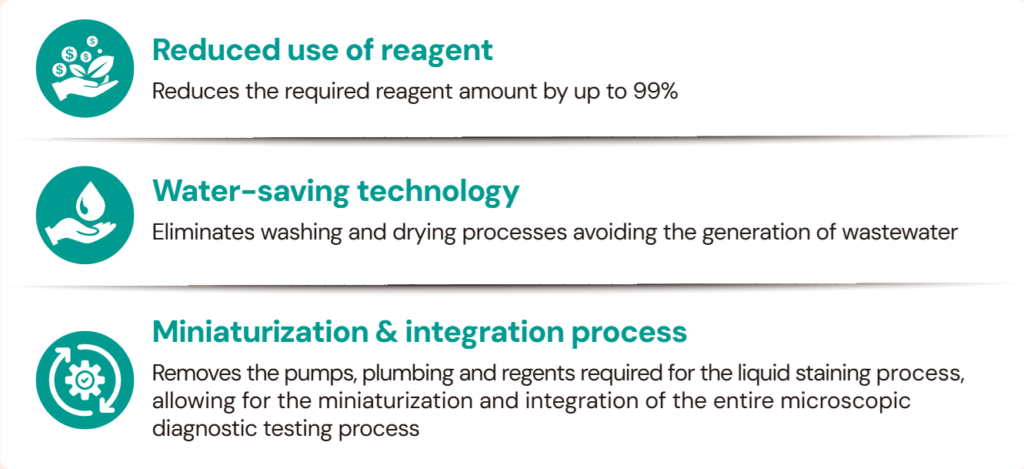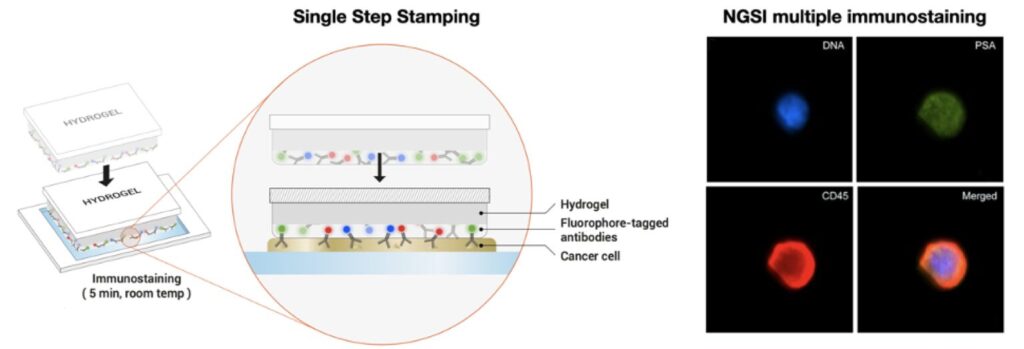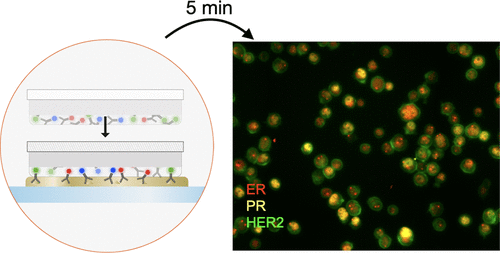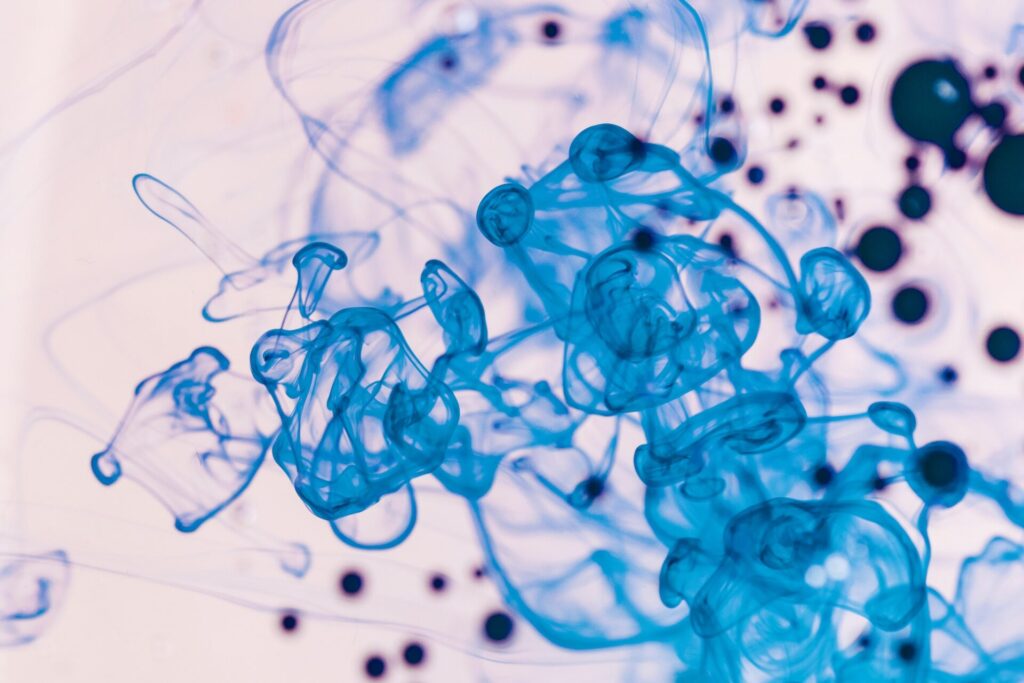Next Generation Staining and Immunostaining, or NGSI, technology represents a bold new step in immunohistochemistry (IHC) staining. This novel approach relies on solid-based staining technology, pressing a stain containing hydrogel material against a sample.
The benefits? Well, where traditional IHC methods are time-consuming, resource-intensive, and non-eco-friendly, NGSI minimizes waste and maximizes accuracy, all while saving researchers and clinicians’ time.
NOUL‘s hydrogel-based NSGI technology, in particular, is a revolutionary alternative to conventional approaches. It represents a paradigm shift away from the liquid-based staining that’s defined science for the past 100 years. The potential for diagnostic pathology is only just being realized.
Learn more below.
Challenges of Conventional Staining Methods
Traditional staining methods involve multiple complex steps, such as paraffin embedding, buffer washing, and antibody staining. For instance, preparing a single slide can take several hours and consume expensive reagents. It’s a laborious and painstaking process that presents numerous problems.
These include:
- Staining takes far longer than necessary. Repetitive washing and blocking steps waste precious time when analyzing a sample.
- High consumption of reagents. To achieve the final slide, the materials must be prepared with expensive antibodies and buffers.
- Global diagnostic disparities. The uneven distribution of diagnostic resources and technologies impacts healthcare efficiency and effectiveness, especially in low- and middle-income countries.
- Environmental concerns. The quantity of potentially hazardous liquid waste exacerbates sustainability challenges in the industry.
- Skill dependency. Reliance on extensively trained personnel significantly limits accessibility and practicality in low-resource settings where such expertise is scarce.
NGSI Technology: Revolutionizing Staining with Hydrogel

Source : NOUL
What’s the solution? Over 100 years since standard immunohistochemistry staining took precedence, a new form of staining is gaining traction. Hydrogel stamping introduces a solid-phase, biopolymer-based staining method that uses pre-embedded hydrogels with dyes to achieve impressively precise results.
At the heart of this innovation is the use of uncharged agarose hydrogels, which are expertly designed for optimal dye absorption and transfer. This smart approach preserves cell structures perfectly, boosting the reliability of diagnostic results—really crucial for accurate diagnoses.
Let’s take a closer look:
NOUL’s groundbreaking approach eliminates much of the need for liquid-based reagents. The process saves up to 99% of reagents compared to conventional methods – significantly helping with water conservation methods.
Moreover, it eliminates the time-intensive need for repetitive washing and drying processes. In fact, the entire immunostaining procedure is reduced to under five minutes. That will substantially increase the throughput in diagnostic settings, saving valuable time and boosting patient satisfaction.
Thanks to these innovations, the hydrogel-based NGSI technology eliminates wastewater entirely, contributing to environmentally friendly laboratory operations. It is about as environmentally friendly as modern diagnostic procedures can be. For labs and research facilities keen to minimize their environmental footprint, it’s most certainly a step in the right direction.
Plus, the technology remains highly adaptable. It can miniaturize diagnostic tools, perfect for supporting multiplexed immunostaining with different hydrogels. Such flexibility makes it highly sought-after by model labs focused on sustainable, smart testing.
Research-Backed Findings and Validation
 Source : NOUL
Source : NOUL
NOUL isn’t just making grand claims. We’ve got the evidence to back up this groundbreaking approach to immunostaining.
In a 2021 paper titled Hydrogel-Based Stamping Technology for Solution-Free Blood Cell Staining, researchers tested this immunostaining method. They found that the process:
- Reduce staining times by sixfold
- Decreased reagent usage by 88%
- Delivered staining quality comparable to traditional high-precision automated systems
In short, it was an unmitigated success. The researchers went even further in their findings. The hydrogel staining methodology was highly effective at detecting malaria-infected red blood cells without requiring any “special skills” to produce “excellent quality-stained blood film slides.” This is perfect for resource-limited settings where advanced specialists aren’t available.
Furthermore, the method can successfully identify up to nine biomarkers in breast cancer diagnostics. It indicates a potential in oncology and other aspects of precision medicine. Indeed, layering hydrogels embedded with diverse strains enables advanced diagnostics, facilitating the rapid and precise detection of multiple biomarkers simultaneously. Diagnostics for certain diseases might go from hours to just minutes.
With fewer resources, greater efficiency, and simpler processes, hydrogel immunostaining represents a transformative solution to the ever-present challenges of modern diagnostics. The impact cannot be understated.
Applications and Global Impact
 Source : NOUL
Source : NOUL
The big question is, what does this all mean? How will a revolutionary approach to immunostaining impact the globe? Well, it’s clear from the outset that the technology shines in a few particular areas, including cancer diagnosis, infectious disease detection, and drug development. Already, as we’ve shown, it’s worked wonders in malaria and breast cancer diagnosis.
What’s more, NGSI’s scalability means it fits right into any lab size, requiring minimal setup and training. This is a big deal for clinics everywhere, particularly in resource-limited areas, as it slashes operational costs and cuts down on waste with its eco-friendly biopolymer tech.
By simplifying and democratizing high-quality diagnostics, NGSI is paving the way for more equitable healthcare. Whether it’s a high-tech lab in a major city or a small clinic in a rural area, this technology brings top-tier diagnostics to the table, bridging gaps in global healthcare and setting new standards for the future of medical testing.
Even in more advanced healthcare settings, NGSI’s ability to cut costs and speed up diagnosis is an attractive feature for societies dealing with aging populations and increasing pressure on existing healthcare systems.
Conclusion
 Source : Freepik
Source : Freepik
NGSI combines hydrogel-based staining and cutting-edge digital imaging to revolutionize immunohistochemistry staining. It’s a landmark moment for scientific advancements. The benefits are clear: faster diagnoses, greater precision, and less environmental impact.
NOUL is at the forefront of this change. Our commitment to advancing diagnostic efficiency and environmentally friendly technologies is steadfast. We know that with the right biopolymer-based tools, we can transform how diagnostics are done around the world. It’s a promising future where effective, sustainable medical practices are within reach for all.
Transform your lab today with NGSI technology. Contact us for a consultation and discover how our hydrogel-based innovations can enhance your diagnostics while cutting costs.

